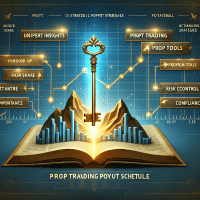Introduction: The Evolving Landscape of Prop Trading Payout Models
The proprietary trading environment demands speed, precision, and reliability, especially when it comes to payout mechanisms. As prop traders navigate an increasingly competitive market, the debate of Vantir vs Traditional Payout Models – speed and trust mechanisms is pivotal. In this article, we break down the key differences between these payout systems, explore advanced backtesting methods, and provide practical strategies to help you gain a competitive edge.
Understanding how payout speed and trust mechanisms affect your trading outcomes can make the difference between a seamless trading day and costly delays. For prop firms and individual traders alike, integrating robust backtesting frameworks with reliable payout systems ensures that you are always a step ahead in the market.

Deep Dive: Vantir vs Traditional Payout Models
When evaluating payout models for prop trading, the primary factors to consider are speed, transparency, and trust. Vantir payout models stand out by offering near-instantaneous speed and innovative trust mechanisms that foster a more reliable payment ecosystem. In contrast, traditional payout systems often struggle with slower processing times and less robust verification processes, which can hamstring traders during volatile market phases.
Speed and Confidence in Payouts
A faster payout system directly translates into enhanced liquidity and reduced downtime, ensuring that traders can reinvest profits swiftly. Vantir models usually leverage automated systems that reduce manual intervention, minimize commissions, and tightly integrate risk management protocols, offering faster resolution times compared to their traditional counterparts.
Trust Mechanisms and Compliance
Trust is built on transparency and regulatory adherence. Emerging Vantir systems incorporate advanced encryption, multi-layer authentication, and compliance with international regulations such as MiFID II, ESMA, and NFA rules. Traditional systems typically rely on legacy infrastructure that may not fully adapt to current regulatory environments, resulting in potential compliance risks.
Backtesting Tools in Prop Trading: The Essential Comparison
In parallel with payout mechanisms, the efficacy of a trading strategy is heavily reliant on robust backtesting. Automated tools in the prop trading space allow traders to simulate and refine strategies with historical data. Let’s compare some of the most widely used platforms:
| Tool | Backtesting Features | Data Quality | Integration | Pricing & Use Case |
|---|---|---|---|---|
| TradingView | Vectorized backtesting, strategy optimization | High-quality historical and real-time data across multiple assets | API access; broker integration with Interactive Brokers | Freemium model; ideal for individual traders and small prop firms |
| MetaTrader 5 | Event-driven mechanisms, commission/slippage modeling | Comprehensive forex and CFD data | Direct broker integrations; extensive MQL5 script library | Low cost; popular among retail and semi-professional traders |
| QuantConnect | Automated parameter optimization, walk-forward analysis | Deep historical data covering equities, forex, and derivatives | API integration; supports multiple brokerage platforms | Subscription based; best for quantitative teams and high frequency strategies |
This comparison highlights the contrast between user-friendly features (TradingView and MetaTrader 5) and highly customizable, robust backtesting environments (QuantConnect) suitable for advanced prop firm operations. Each tool offers automated backtesting solutions beyond mere historical data playback by incorporating features like automated parameter optimization, scenario analysis, and comprehensive report generation.
Advanced Backtesting Concepts: A Prop Trader’s Guide
Advanced backtesting is a cornerstone of successful prop trading strategy development. However, it comes with potential pitfalls that must be expertly navigated to yield reliable results.
Mitigating Common Backtesting Pitfalls
Overfitting, survivorship bias, look-ahead bias, and data snooping are frequent challenges. To mitigate these issues, use out-of-sample testing and incorporate walk-forward optimization. For instance, walk-forward analysis divides historical data into segments, continually testing and updating strategies to align with new market conditions.
Integrating Backtesting and Forward Testing
Before deploying live, integrate backtesting results with forward (paper) trading. Monitor key performance metrics such as Sharpe Ratio, maximum drawdown, and profit factor during forward testing. A well-structured testing regime bridges the gap between simulated strategies and live market performance.
Case Study: Enhancing Strategy Robustness
Consider a renowned prop trading firm that recently integrated QuantConnect’s automated backtesting with a Vantir payout system. The firm faced challenges with overfitting and delayed payouts. By reconfiguring their testing protocols to include walk-forward optimization and automating advanced parameter scans, they saw a 15% improvement in their Sharpe Ratio and a significant reduction in drawdown. Moreover, the rapid payout speeds of Vantir allowed the firm to reinvest profits quickly, enhancing liquidity and operational efficiency.
Pro Tip: Automating Strategies with Code
Leverage code to automate your strategy backtesting. Consider the following Python snippet using Backtrader:
import backtrader as bt
class TestStrategy(bt.Strategy):
def __init__(self):
self.sma = bt.indicators.SimpleMovingAverage(self.data.close, period=15)
def next(self):
if self.data.close[0] > self.sma[0]:
self.buy()
elif self.data.close[0] < self.sma[0]:
self.sell()
if __name__ == '__main__':
cerebro = bt.Cerebro()
cerebro.addstrategy(TestStrategy)
data = bt.feeds.YahooFinanceData(dataname='AAPL', fromdate=datetime(2020, 1, 1), todate=datetime(2021, 1, 1))
cerebro.adddata(data)
cerebro.run()
cerebro.plot()
This code serves as a foundation for automating and backtesting your strategies. Adjust the parameters and indicators based on your strategy's specifics.
Key Regulatory and Compliance Considerations
For prop trading firms, maintaining compliance is non-negotiable. With frameworks like MiFID II, ESMA regulations, and NFA rules shaping financial markets, it’s critical to integrate compliance checks into both payout systems and risk management strategies. Advanced tools now include built-in compliance modules to help mitigate regulatory risks.
Risk Management and Compliance Tools
In addition to automated backtesting solutions, risk management checklists and trading journals are essential. Below is a brief outline of a Risk Management Checklist resource that prop trading teams can utilize:
- Market Entry/Exit Strategies: Define clear criteria for opening and closing positions.
- Position Sizing: Use calculated risk ratios to determine trade sizes.
- Stop-Loss and Take-Profit Levels: Predefine exit points based on volatility and historical performance.
- Performance Metrics: Monitor Sharpe Ratio, drawdown, and profit factors.
- Compliance Checks: Regularly review adherence to MiFID II and ESMA guidelines.
This checklist, when integrated with automated backtesting tools, can help firms ensure that risk is minimized and strategies are compliant with international trading standards.

Integrating Insights for Prop Trading Success
Prop trading requires an integrated approach – one that blends speed, trust, and rigorous strategy testing. As discussed, choosing a modern payout system like Vantir can significantly enhance liquidity and operational speed, while robust backtesting through platforms like TradingView, MetaTrader 5, and QuantConnect can refine your strategy, mitigate risks, and optimize performance.
Tailored Advice for Different Roles
For junior traders, focusing on precise execution and understanding basic backtesting metrics is key. Senior quants and risk managers, on the other hand, must delve into sophisticated data analysis, leverage advanced optimization techniques, and ensure that both strategy performance and payout compliance are at optimal levels.
Actionable Next Steps
To further enhance your trading strategy, consider these actionable steps:
- Review your current payout structures and assess if a shift towards faster, trust-enhanced systems such as Vantir can streamline operations.
- Implement advanced backtesting using a combination of forward testing and walk-forward optimization.
- Download our comprehensive Risk Management Checklist to ensure your strategies adhere to both market and regulatory standards.
- Explore our in-depth guides on TradingView and QuantConnect integrations, available on our internal resources page.
For a detailed checklist and further insights, visit our resource page on advanced trading strategies.
Conclusion
In the competitive realm of prop trading, understanding the nuances of payout mechanisms such as those offered by Vantir vs Traditional models can be transformative. Coupled with advanced backtesting and robust risk management practices, these insights enable traders to optimize performance, reduce risks, and accelerate growth. As of October 2023, businesses and individual traders alike are urged to integrate these proven techniques, ensuring that every trade is executed with precision and backed by reliable data.
Embrace the dual benefits of optimized speed and enhanced trust mechanisms in your trading operations, and stay ahead in the dynamic landscape of prop trading.
Note: All trading and investment strategies discussed are for educational purposes and should be accompanied by professional consultation.







